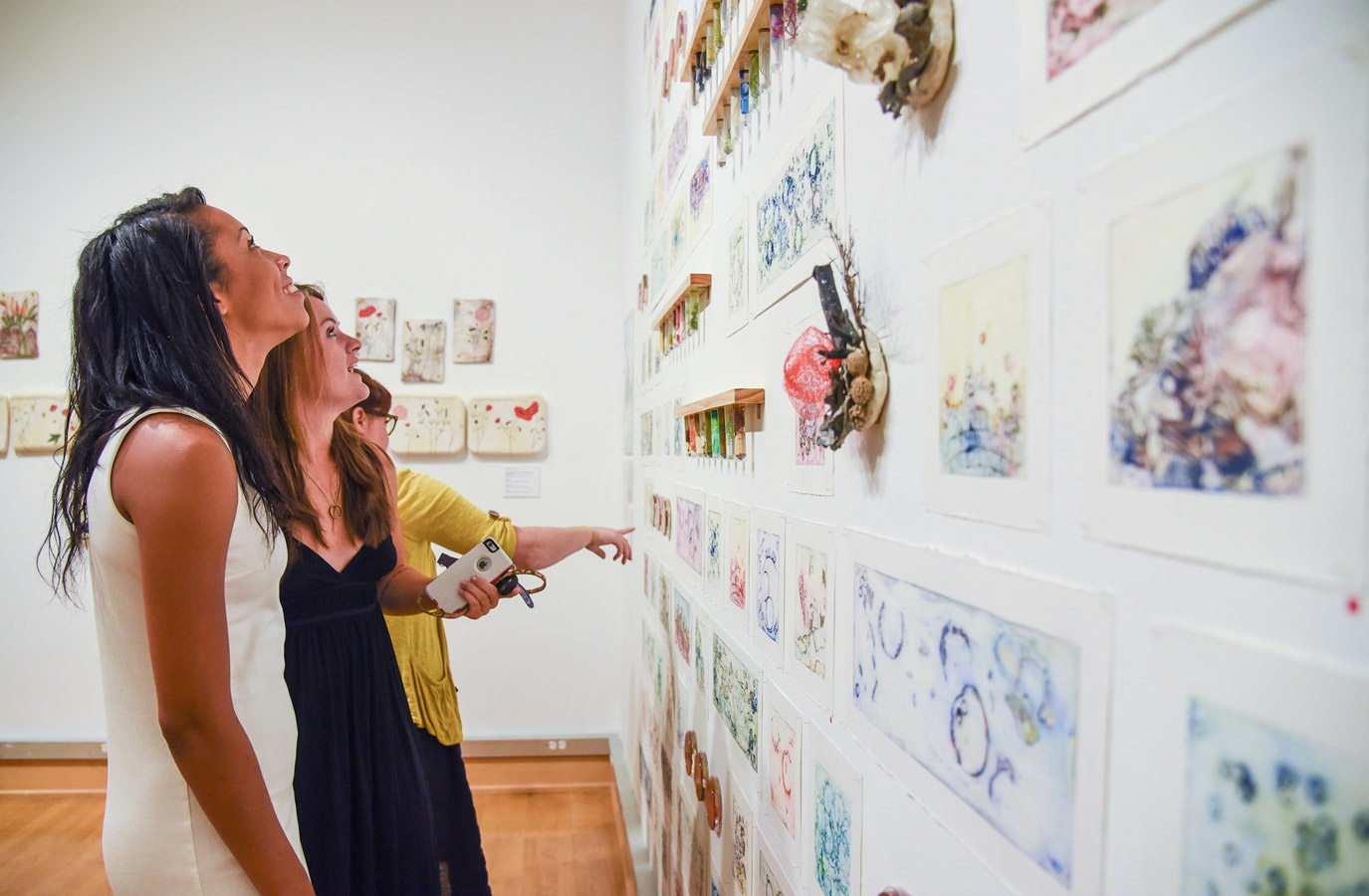Senior Projects Spring 2025
April 18 – May 2, 2025
WASMER ART GALLERY
Opening Reception and Artists' Presentation
Thursday, April 17, 5:00-7:00 p.m.
Faculty mentor: Patricia Fay
At the end of their studies, art majors are required to develop and present a coherent
body of self-generated work. This exhibition combines their knowledge of techniques
and concepts while drawing on research of historical and contemporary artists. Each
senior art major in the exhibition designs and creates a unique installation that
combines their technical skills and conceptual vision.
Sponsored by The Layden Family Foundation, The Smith Family Foundation of Estero, and WGCU Public Media.
Image Credit: Brigette Baker, Permanent Transition, 2015, Installation view of Senior Project
-
Emma Bradley MONOMANIA
Toggle More Info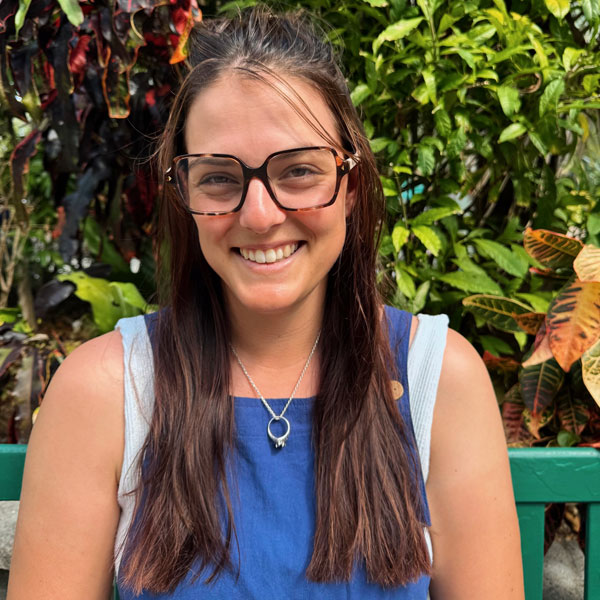
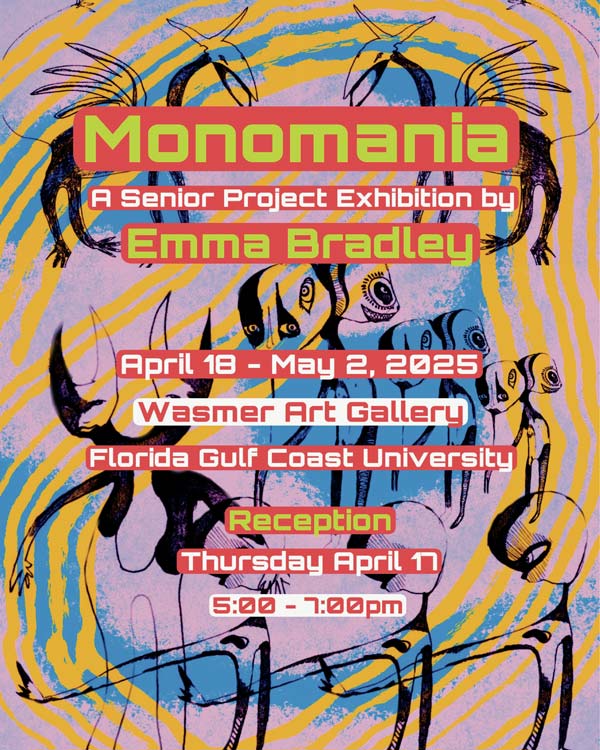
Art has long served as a powerful medium for self-expression, communication, and the exploration of identity. For neurodivergent individuals, creative practice often becomes a bridge between internal experience and the external world, a unique channel for storytelling and self-discovery. Similarly, childhood athletes, especially in precision-based sports like golf, develop a deep relationship with discipline, repetition, and mental resilience - qualities that can profoundly shape their engagement with art. In this project I use digital and physical methods to explore my newfound identity as a visual artist. I use both abstract and formal color fields, and represent my state of being through the imagery of “creatures” that capture the emotional space between myself and them.
Monomania - an intense focus on a singular pursuit - can be both a tool and a tether. For years, golf defined me. It wasn’t just a sport; it was structure, validation, and the space where I thrived even as I struggled with learning disabilities. My identity was built around precision, repetition, and mastery. But when that world ended, I was left with a void. Who was I without it? This exhibition is about the search for identity through creative practice. As an athlete, my world was measured in wins and losses, governed by structure and control. Art offered something unfamiliar: an open-ended process and a space to express myself. Where I was once frustrated in traditional learning, my neurodivergence has become the strength in my creative work. I now embrace imperfection, asymmetry, and layering both conceptually and physically as a reflection of the nonlinear journey of self-discovery.
My work lives in the intersection of obsession and transformation. The creatures I create express the fragility and volatility of my emotional states. Being neurodivergent often leads to heightened physical and emotional expression, and this obsessive nature emerged powerfully in this project. The creatures became vessels for that experience. To bring them to life I worked across multiple mediums. For the 24” x 36” digital collages I used Procreate, a digital painting tool. My 20” x 20” physical collage was created on masonite board using old book pages, ink, acrylic paint, and Mod Podge. My 4” x 6” panels are made from red earthenware clay, low-fired at 1728°F, painted with underglaze, and refired to 1888°F. My drawings use black ink, Micron pens, and water-diluted ink pencils.
-
Haley Cai Fox CARRY YOU IN MY BONES
Toggle More Info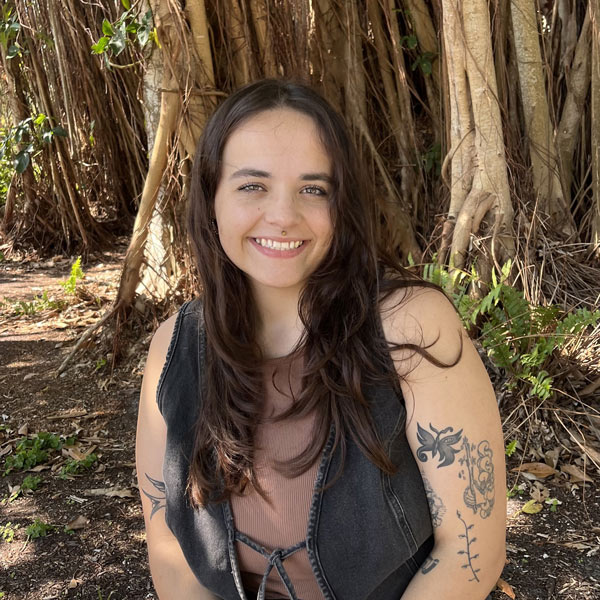
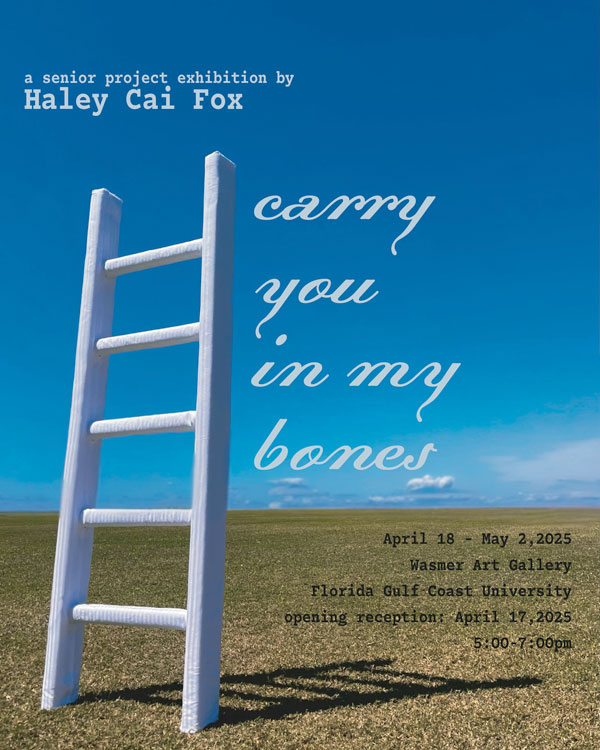
Grief and bereavement refer to the feelings that come after the loss of a loved one. Going through these kinds of traumatic experiences rewires the brain and dysregulates the nervous system. The pace of Western society rarely and reluctantly accommodates the mental and physical demand of grief and bereavement. In response, many people learn to suppress their natural emotional processes, which has the potential to lead to even more negative effects. With my installation I wanted to create a space to bring awareness to the importance of healing and acknowledging grief. My intention is to encourage viewers to engage in healthy healing practices and foster a continued connection with the ones they have lost. There is no singular way to approach healing, and coming from a mixed race heritage, I have been inspired by various cultural forms of ancestral connection. Egungun, or masquerade performance of the Yoruba People in West Africa, is an example of community coming together to heal, acknowledge, and keep the spirits of their ancestors alive. I believe engaging in these traditions in communal spaces for remembrance can be crucial to one’s journey to healing from loss.
The grief I carry began before I was born, when my mother lost her mother and sister to domestic violence. My understanding of this tragedy developed slowly over the years, as it was a piece of my family’s history too painful to discuss. It was not until themes of grief kept showing up in my artwork and poetry that I fully recognized the internal impact I felt from their loss. Carry You in My Bones combines the methods I have used to support my healing through keeping heirlooms, altar practice and mediumship. The Yoruba word for “ancestors” is Egun, which when pronounced in a different tone, also means "bones.” This resonates with me because it implies even if we have never met, my grandmother and aunt’s existence is inherently intertwined with my own. Some of the earliest forms of written communication were used to connect with the gods and describe afterlife navigation to those who have passed on. For my project, I developed my own symbolic language – Caiglyphs – to represent the complexity of healing from grief. Another ancient practice spanning many cultures are altars, a designated place for worship and remembrance. Carry You in My Bones acts as a designated place to inspire that connection in myself and in the community.
In order to welcome viewers into a space for healing I wanted my installation to be comforting and interactive. To incorporate my symbolic language into the Caiglyphs tapestry, I carved twenty-seven individual symbols into 6”x 6” linoleum plates and printed them onto fabric squares. Cycle Breaker features a large figurative linoprint in the center of the tapestry, and within the border I cut and sewed fabric appliques of the Caiglyphs to represent my own personal journey with grief. For Ghost Object #1: Ladder, I constructed the frame out of wood and upholstered it with foam and white fabric. For Ghost Object #2: Chair, I used fabric and poly-fil to keep it lightweight and airy. Both objects interact with the tapestries behind them, pushing their narrative into the viewer’s physical space. Finally, the interactive piece, Come Closer Children, I Have A Story, incorporates handmade wooden stools and soft sculpture. The storytelling figure was made using nylon fabric stuffed with plastic bags, packing peanuts, and poly-fil wrapped with more fabrics and threads. Carry You in My Bones invites viewers to sit with their grief, but to remember and feel connected with the ones they have lost.
-
Paige Hollopeter THE ART OF REMEMBERING
Toggle More Info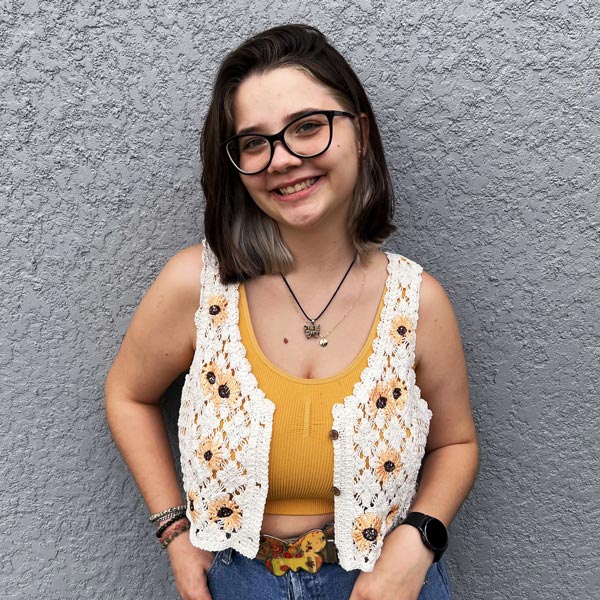
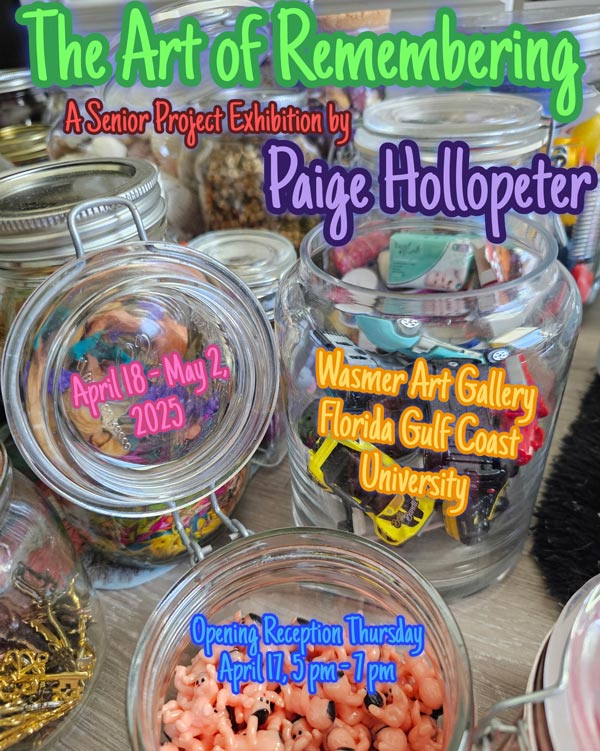
Children who grow up in difficult and unstable homes often carry deep emotional wounds that last a lifetime. Living with neglect, abuse, or constant uncertainty creates overwhelming feelings of anxiety, loneliness, and self-doubt. Many of these children grow up fearing abandonment, never knowing what to expect or who they can truly rely on. I am part of this equation. The effects of childhood trauma have made it harder for me to focus in school, trust others, or even feel safe in my own skin. Healing from a dysfunctional upbringing isn’t easy, but I learned how to support myself through creating art. The process of making helped me regulate all of the strong emotions I felt as a child and gave me a sense of self-control in my life when I couldn't find it in my home.
I was 9 when my parents divorced and each of them had deep-rooted issues that seeped into our home lives. Growing up in two households was difficult to grasp at a young age, especially with parents facing internal struggles. It was necessary for me to take on a parental role for my siblings, which was quite challenging as a teenager, while also taking care of myself. During all of these difficult points in my life, I found myself obsessively accumulating “things”. These things can be described as hyper-fixated collections to keep me occupied when chaos was swarming around me. They gave me a safe space and allowed me to have a sense of pleasure when I couldn't get it elsewhere. With these things around, I created a sanctuary in my room that made me feel safe, in control, and seen. My work for Senior Project shows the perspective of my childhood and attachments to items I've collected. Displaying all of my things at once in an explosion of color, texture, and chaos has allowed me to show a lighter side to the childhood trauma, while also still bringing in the darkness of what I faced.
Making art has always been therapeutic for me. Taking all of my things and incorporating them into my artwork has now become my preferred method of creating art. Automatism is a style and method I've used lately as it allows me to be completely free with what I'm creating without a conscious thought. I describe my work as mixed-media; I thrift and get a lot of my found objects either secondhand or free. Working for Goodwill for the last three years has also helped ignite my passion for using preloved items to create artwork and give them a second chance at life in my creations. My preferred medium is painting with acrylic and for this project I have been painting on found objects like shelving units or thrifted wooden disks. My goal for my work is maximalism at its finest. The more that I can add, adhere, paint, and build on, the more I have achieved my goal.
-
Emily Leeper DEVOTION
Toggle More Info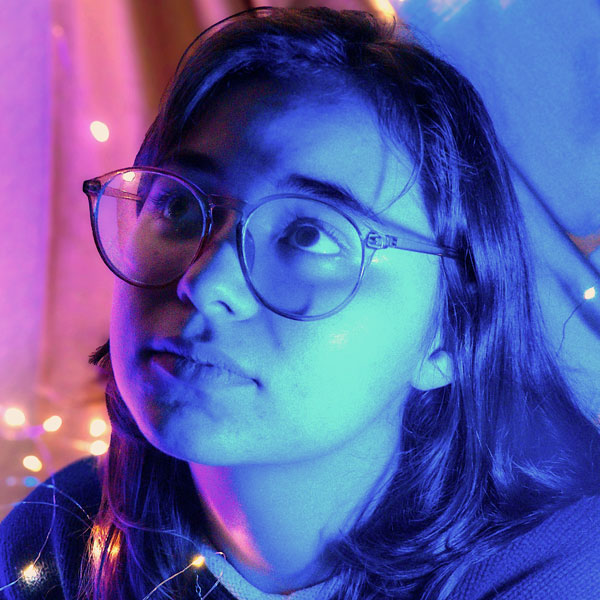
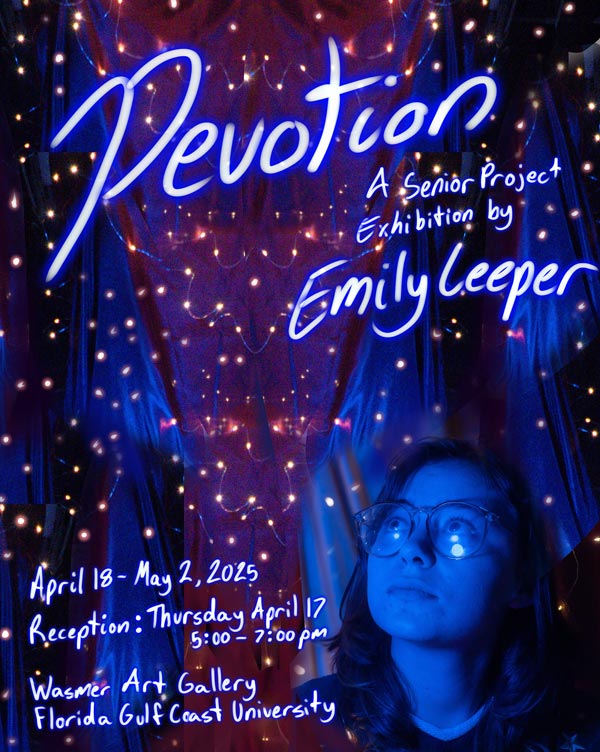
When people use the word “devotion” some may think of God or a higher power, of something held in great reverence. Growing up without a strong spiritual upbringing made me envious of others’ ability to be devoted to things such as religion, but I lacked the belief and background. Devotion is generally seen as religious; my intention is to show how I, a non-religious person, find my own way of practicing devotion. When I think of devotion, I think of everything that has created me. With this exhibition I want to show the depth of my passion for the things that matter to me in life, and explore my own relationship with spirituality.
For my Senior Project I chose to use fabric as a medium due to its tactile nature and my personal connection with fabrics. I have always had an attachment to blankets and clothing as they have given me comfort throughout my life and connected me to others. Blanket forts and dress-up costumes give me a strong sense of nostalgia that I wanted to capture, as well as a sense of home and familiarity from the specific use of secondhand fabrics. Choosing to print images on fabric and paper with linoleum blocks offered a handmade quality throughout the installation. For the imagery, being able to see snapshots of moments of happiness, no matter how small, was very important to me. They highlight the root of my devotion, which is the mundane things in life that bring me joy. The imagery of stained glass within the prints is a way for me to connect with the feeling that these are devotional moments. The lanterns are about a different type of devotion; they represent a symbolic devotional attachment towards celestial objects like the sun, moon and stars. The sun, the largest star in the sky, to me is the future, is everything I want to be. The moon is my past, the things I love, the things that remind me not only of who I am but why I do anything. And the stars, the stars are dreams, reminders, not the same as the dreams for the future, but they are little dreams, small actions that I hope for. These ideas have come together and been instilled in these lanterns, and I made them to remind the audience of their own wishes and dreams.
I chose to create an interactive installation because I wanted to invite the audience to see through my eyes and be enveloped in this devotional space. I felt that to understand how overwhelming these feelings can be needs a space that you can walk into and become a part of, rather than just an object to observe. Through immersion and interaction with this work I encourage the viewer to see themselves through this lens, and to picture their own devotions and the things that they are devoted to.
-
Cheyanne B. Lewis FAMILY MATTERS
Toggle More Info
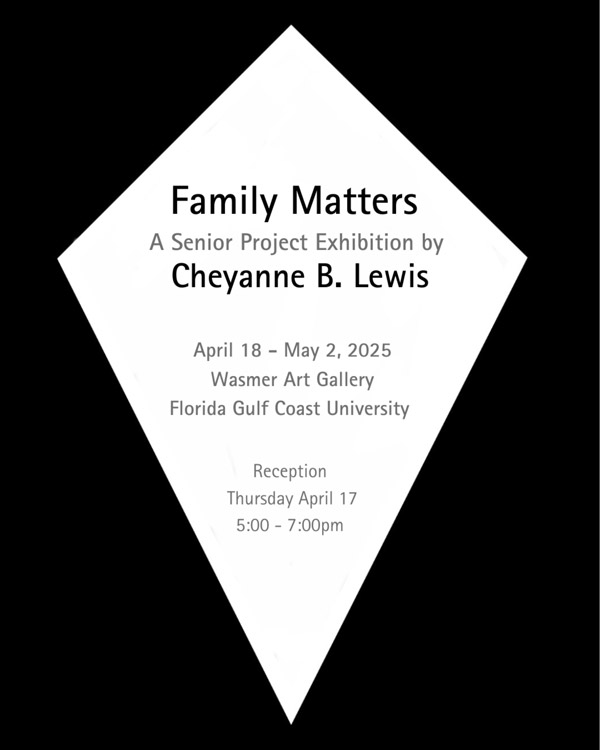
Through my parents and grandparents I truly learned the importance of family. The works in this exhibition pay tribute to the family members who kept me grounded and protected from trauma. In the African American community many of us suffer from childhood ordeals caused by some of our relatives, and were told by these same relatives that “families must love and accept each other no matter what they do”. I learned that I do not have to accept hurtful behavior from those close to me but I must forgive them in order to stay strong and overcome what they put me through. Thankfully I also had family members that kept me protected, guided me throughout my childhood, and gave me beautiful memories to remember.
My Mama, my paternal grandparents, and my Pops (who is not my biological father but a man I consider my dad), kept me protected and grounded. As I go through the adulting phase in my life, I am leaning on my loved ones' teachings now more than ever. I hold my parents and grandparents' teachings close because their words and love were always real and honest. I also remember the words and actions of those other relatives to make sure I never become anything like them. Family Matters is a four-sculpture series that was created to say thank you to the most important adult family members in my life and showcase their powerful lessons. My Mama taught me the importance of Fortitude of the Mind and Soul, my Pops taught me Nobility in Endurance, Granddaddy Terry showed me Stillness in Solitude, and Grandma Carolyn gave me Genuine Love and Warmth.
I like working in metal; it has a hard exterior but it’s mendable. Metal can be very dangerous, however it is also protective. I wanted a shield-like sculptural form to represent the protection offered by my parents and grandparents. In a way, metal also represents the people who had to stay strong for me even when things were hard for them. I use triangles to reference the Holy Trinity, the Father, the Son, and the Holy Spirit. For me this is a way to keep God in my work, who gave me the gift to use my hands for creating. The surface patinas and spray paints in different colors on the metal sculptures helps me with portraying my subjects: the dark blue paint references tranquility, the orange patina represents warmth and the black paint embodies my African American heritage. The steel has two surface textures; the matte texture symbolizes unspoken presence and the polished texture exemplifies rejuvenation.
-
Adrianna Meucci THE HERO WITHIN
Toggle More Info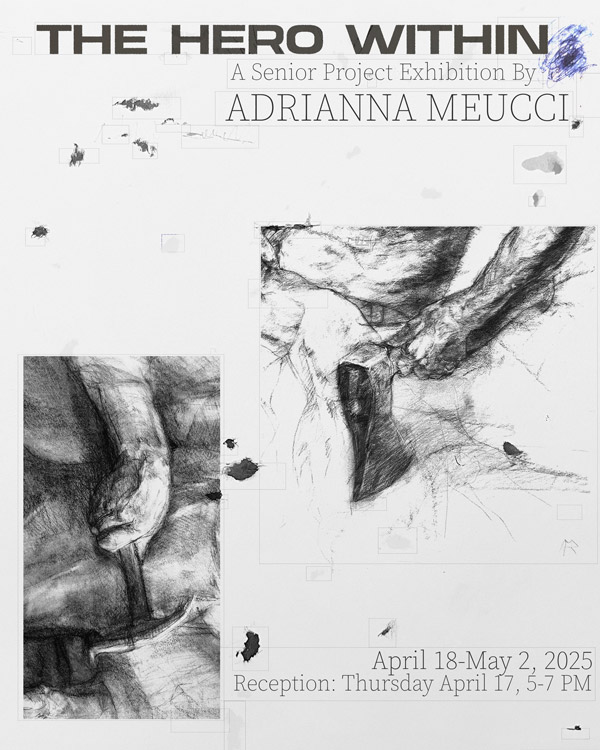
I often lament how our country is no longer beautiful, but I never really thought about why it was beautiful and who exactly made it beautiful. The antiquated professions of shoemakers, day laborers, steelworkers, and lumberjacks that our forefathers pursued have been phased out from globalization, cheap labor, automation, and offshoring. The lost craftsmanship of European immigrants reflected the heart and soul of our nation. Without their skilled hands, we simply would not have the incredible civilization that we have the privilege of living in today - they built our country, and they built it well. Coming from a blue-collar Italian American background, I have seen how technology has replaced valued occupations of the working classes, and how this process has moved my tight knit family away from their communities to find work elsewhere. I do not believe that the American people are interchangeable economic units whose sole purpose is to generate wealth for increasing the GDP.
From the late 1400’s up until roughly the 1930, the majority of America’s voluntary immigration came from Europe. The national ancestry and occupation of these immigrants was varied; many were skilled laborers. The immigration from the 15th to the 18th centuries was typically from France, Germany, Holland, England, and Scandinavia. In the latter half of the 19th and early 20th century came the newer European immigrants, such as the Italians, Romanians, Russians, Poles, etc. This later immigration is the story of my family: the invention of the telephone from my ancestor Antonio Meucci; my great-grandfather taking part in building Saint Patrick’s Cathedral in New York City; as well as stone carvers, carpenters, and glassblowers. I have seen my family work in blue collar and highly skilled jobs to build this country with their hands, hearts, and minds. That is why I chose these images to draw.
I portray American workers for what they are: everyday heroes. Creating the portrait of a hero conjures up images from comic books, or even from artists like Norman Rockwell, but in truth these hardworking heroes are all around us. I created these drawings by invoking an anatomical, academic style based on Italian Renaissance master drawings. I wish to capture American hand labor through the lens of something greater, as a spectacle of “high art”. I provide a humanizing space - a pensive space to reflect on those that came before me, to see working bodies in motion, or a distilled moment in time where they’re in their element. Friends and family have graciously posed for me to capture their likeness. To highlight these individuals, I have used different tones and sizes of paper, along with different materials, such as sanguine chalks, charcoal, watercolor, colored pencil, graphite, gouache and charcoal. Everyone has someone they know that works in the trades or works with their hands. This space honors their hard work for our country and expresses the utmost gratitude for their lasting contributions.
-
Kristina O'Connell COMPANIONS
Toggle More Info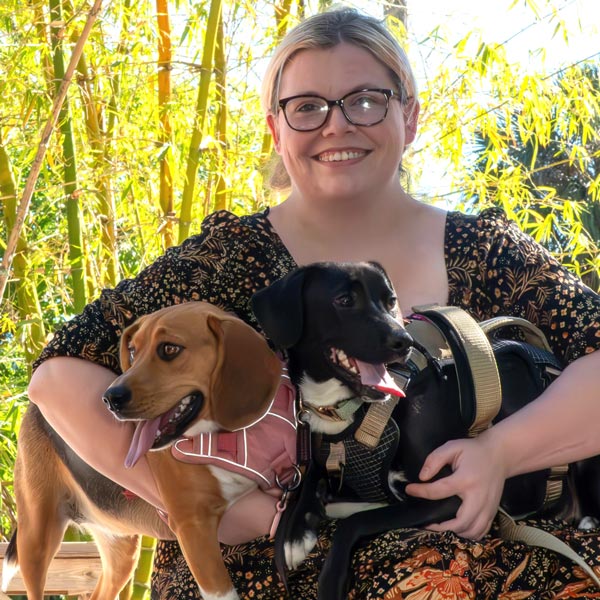
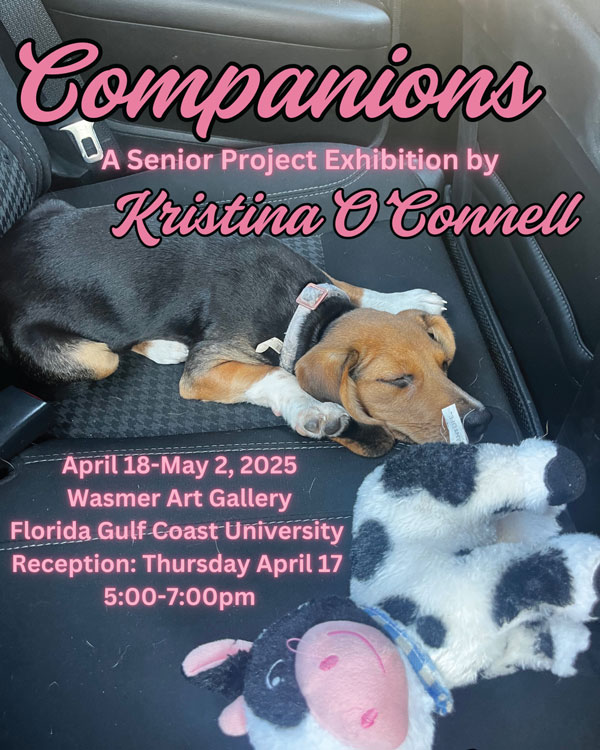
“A dog doesn't care if you're rich or poor, educated or illiterate, clever or dull. Give him your heart and he will give you his.” ~ John Grogan, Marley and Me
During our lives, we seek many forms of companionship and connections with both humans and animals. In particular, we have a powerful connection to our pets, especially dogs, that has been developing over time. Dogs help us in many ways, whether that is by being there for us when we are lonely, watching over those with specific medical challenges or providing that source of happiness we need when we do not know we need it. They help reduce our stress when they are near and give us a form of friendship that is unbreakable. Dogs are known to be man’s best friend, following us throughout their lives and helping us in any way possible. The connection between a human and a dog is quite extraordinary and lasts a lifetime even after one loses the other.
Growing up, I was raised by my grandparents. I moved around a lot and never got the chance to build lasting friendships. I felt very alone and isolated which caused me to seek a form of friendship with my dogs. My dogs are the only constant in my life and they have always been there no matter what and give unconditional love. For my senior project I wanted to showcase the dogs that got me through each day. The companions represented in my work are Cooper, Maxie, Oscar and Daisy. Recently I adopted 2 more dogs named Zephyr and Ariana. I chose specific pictures that represented their personalities and showed the memories that I am most fond of from my early childhood to teenage years. These artworks are a way to honor the companionship they gave me and thank them for getting me through life even during the toughest times.
Painted ceramics has been the medium with which I connect the most. It always relieves my stress and makes me lose track of time. I also chose to do ceramic plates because the process is as delicate as the memories and images displayed on the surface. To begin the process, I first had to go through a series of tests on different clays to find the one that best fit the art both visually and technically. I tested different clays before I settled on Miller EM-100 low fire white earthenware. I very much wanted the appearance of the claybody to be a bright white as I view that color to be delicate and timeless. I created a series of drawings that focus on the memories and images of my dogs that I would be showing on the plates. After the plates were made and bisque fired to 1728oF, I went in with a rough drawing on the plates before painting with ceramic underglaze. Once this was completed, I used Duncan Pure Brilliance clear glaze for a final firing to 1888oF.
-
Eva Poirier MANTRA
Toggle More Info
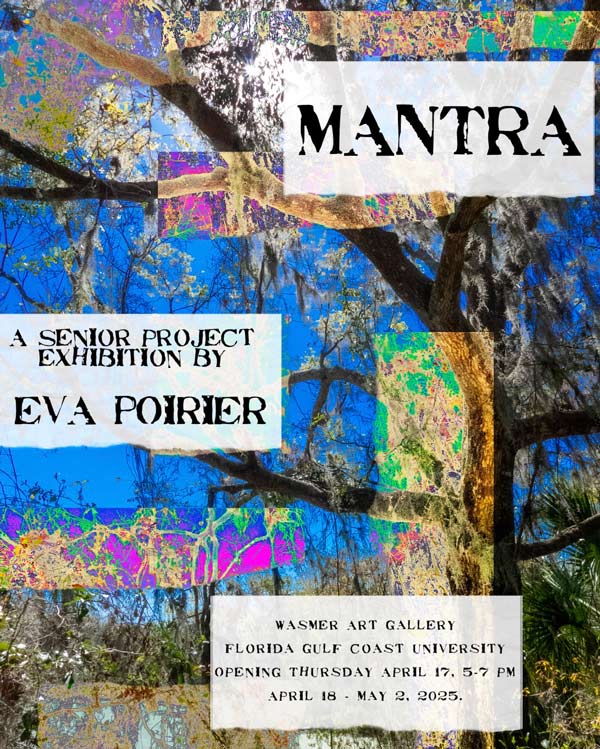
Mantra/ man·tra
- a word or sound repeated to aid concentration in meditation.
Human existence is embedded in the earth. We are connected to the natural world spiritually, a connection strengthened through nature-based meditative acts. When we meditate in the natural world and engage with the elements of the earth, we enter a sacred space where both our physical existence and the elements of the earth converge as one. In this subconscious spiritual realm, we experience feelings, colors, patterns, textures, and movements that contrast yet complement our visual reality. Nature is the mantra of life, and our connection to the earth is reinforced when we meditate in nature and mimic the natural elements. Our deep breaths become tides rolling in and out, our stillness like a tree that stands tall.
As a child, I sat under a giant maple tree in the yard, watching the sun break through the leaves and create shadows on the grass. From those experiences I had growing up, I, without ever realizing it, had developed my own form of meditation and religious practice - the outdoors became my church, and meditation my personal worship. I found comfort with myself physically, mentally, and emotionally through the natural wonders of the Earth. For this project, I chose to capture these sacred moments gained through meditation with printmaking, photography, and text. Each medium used is a different step in that meditative process: the photographs represent what the human eye can see, the edited photograph is the mental state created through meditation, the prints reflect the feelings and movements I experience, and finally, the text records my inner thoughts.
Printmaking plays an essential role in the creation of my body of work, and the process itself is meditative yet unpredictable. Monotypes can only be created by inking up a plexiglass plate and printing it, never to be replicated again and thus symbolizing the once-in-a-lifetime experience. Collagraphs are made through layering gesso onto a blank plate, allowing for intricate details to come through, similar to how in nature we see countless details that can overwhelm us. In contrast, photography allows for the capture of the observable natural world; the camera sees what the human eye sees. After the photo is taken, I experiment with editing software to achieve what I feel is the closest result to the essence of that meditative experience, correlating color to emotions and subconscious thoughts. Lastly, from the journal that is with me on these meditative journeys, I translate what I have written down using individual letter stamps onto notecards gently stained with tea and coffee.


